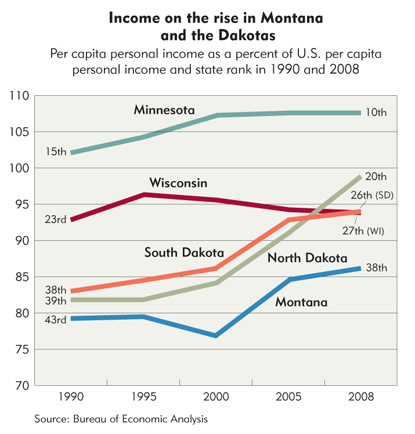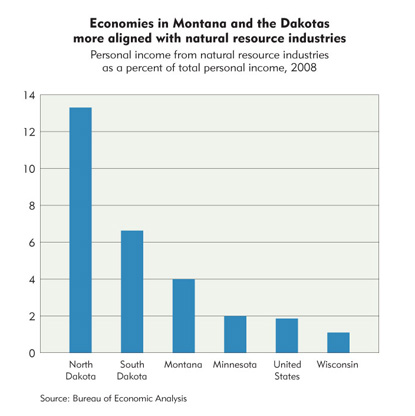After spending years toward the bottom of state per capita personal income rankings, Montana and the Dakotas are climbing the income ladder, thanks to strong economies.
In 1990, North Dakota and South Dakota ranked 39th and 38th, respectively; by 2008, they ranked 20th and 26th. Montana’s ranking went from 47th in 1995 to 38th in 2008. At the same time, Minnesota’s state ranking rose during the 1990s, but has held steady since 2000. Wisconsin’s per capita income ranking dropped from 23rd in 1990 to 27th in 2008 (see chart below).
While the economic downturn has affected Montana and the Dakotas, these states have weathered the recession relatively well compared with the nation. Minnesota and Wisconsin largely followed national trends during the economic downturn.
The superior performance in Montana and the Dakotas appears to be attributable to their heavier dependence on natural-resource-based indus- tries in comparison with other states. Agriculture, mining, oil drilling and forest products have seen strong, if volatile, growth during this decade. Income from these sectors represented 13 percent of total state personal income in North Dakota, 6 percent in South Dakota and 4 percent in Montana in 2008, while representing only 2 percent nationally. As income from these sectors began to expand, so did per capita income.
Agricultural conditions were relatively robust during the past few years, which had an outsized effect on income in these three states. Adjusted for inflation, average national net farm income during the most recent five years (2004–2008) was $73.8 billion, much higher than the average of $54.6 billion for the previous 25 years (1979–2003). Meanwhile, oil production exploded in the Williston Basin, a vast area that straddles North Dakota and Montana. The number of drilling rigs in North Dakota increased from six in July 2000 to 13 in July 2008; Montana saw a jump from 14 rigs to 69. Oil prices soared from $30 to over $100 per barrel during the same period, which increased revenue dramatically.
Mining production also picked up as metal prices increased. Broad measures of metal prices about tripled between July 2003 and July 2006 and remained at high levels until the middle of 2008. While forest products industries showed strong growth during the first half of this decade, the sector has been a drag on natural resources since 2007, but not enough to counterbalance the success in other areas.
While per capita income has climbed out of the basement in Montana and the Dakotas, this is not the first time these states have claimed relatively high levels of per capita income. Back in 1950 when farm income was strong, Montana and North Dakota ranked 12th and 28th, respectively. If overall strength in agriculture, mining, oil drilling and forest products holds up during the post-recession recovery, these states’ per capita income rankings could remain relatively higher. Yet most investors and workers in these industries know that history does have a way of repeating itself.








